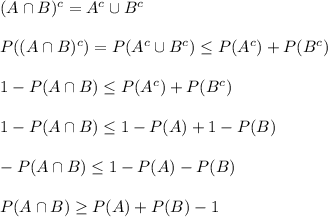For two events a and b show that p (a∩b) ≥ p (a)+p (b)−1.
(hint: apply de morgan’s law...

Mathematics, 10.01.2020 03:31 stacy021603
For two events a and b show that p (a∩b) ≥ p (a)+p (b)−1.
(hint: apply de morgan’s law and then the bonferroni inequality).
derive below results 1 to 4 from axioms 1 to 3 given in section 2.1.2 in the textbook.
result 1: p (ac) = 1 − p(a)
result 2 : for any two events a and b, p (a∪b) = p (a)+p (b)−p (a∩b)
result 3: for any two events a and b, p(a) = p(a ∩ b) + p (a ∩ bc)
result 4: if b ⊂ a, thena∩b = b. therefore p (a)−p (b) = p (a ∩ bc) and p (a) p(b).

Answers: 3


Another question on Mathematics

Mathematics, 21.06.2019 15:00
Find parametric equations for the line tangent to the curve of intersection of the surfaces at the given point. surfaces: xsquared2plus+2yplus+2zequals=1212 yequals=33 point: left parenthesis 1 comma 3 comma five halves right parenthesis
Answers: 1


Mathematics, 21.06.2019 19:30
Sundar used linear combination to solve the system of equations shown. he did so by multiplying the first equation by 5 and the second equation by another number to eliminate the y-terms. what number did sundar multiply the second equation by? 2x+9y=41 3x+5y=36
Answers: 1

Mathematics, 21.06.2019 20:30
choose the correct definition for extremo. a. end b. extra c. extract d. eventual
Answers: 2
You know the right answer?
Questions




Chemistry, 04.04.2020 05:35

Mathematics, 04.04.2020 05:36









History, 04.04.2020 05:36




Mathematics, 04.04.2020 05:37

Physics, 04.04.2020 05:37














